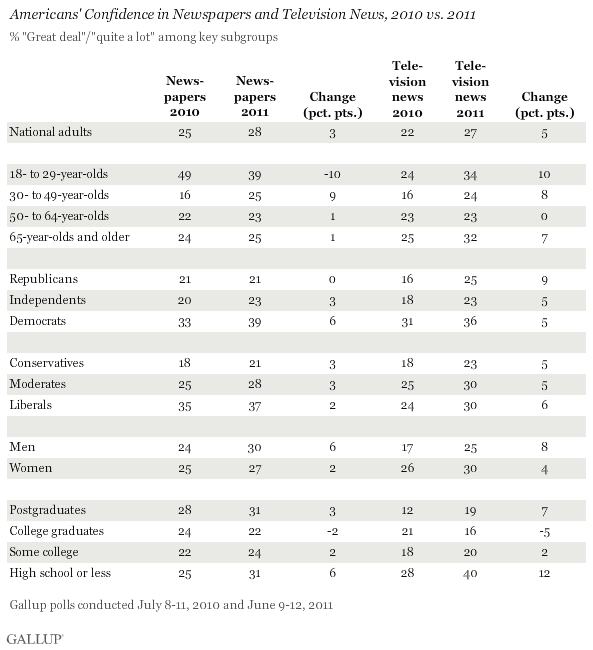WASHINGTON, D.C. -- Americans' confidence in newspapers and television news rebounded slightly in the past year, having been stuck at record lows since 2007. The 28% of Americans who express a great deal or quite a lot of confidence in newspapers and the 27% who say the same about television news still lag significantly behind the levels of trust seen through much of the 1990s and into 2003.

The findings are from Gallup's annual update on confidence in institutions, which found few other notable changes from last year. Newspapers and television news rank 10th and 11th in confidence, respectively, among the 16 institutions tested. While the improvement for each is small in absolute terms, it could mark the beginning of the reversal of the trend seen in recent years. The Pew Project for Excellence in Journalism's annual report on The State of the News Media suggests that the state of the media improved in 2010 as content providers found new ways to meet the changing needs of their audiences as well as new revenue models.
Confidence in newspapers and television news increased across most key subgroups, with the biggest across-the-board improvements among 30- to 49-year-olds and men. The views of Americans aged 18 to 29 exhibited the most mixed year-to-year change, with this group showing a 10-point increase in confidence in television news but a 10-point decrease in confidence in newspapers. While members of this group remain among the most confident in each, their views are now on par with those of Democrats and liberals. Republicans also showed inconsistent movement in their opinions, registering a nine-point increase in their confidence in television news and essentially no change in their views of newspapers. Interestingly, considering the highly polarized nature of cable news, all ideological groups increased their trust in television news to about the same degree.

The widespread improvement in confidence in newspapers and television news is good news for these industries, which have struggled through changes in the way audiences consume news and the way advertisers reach those audiences. Gallup's September update on trust in the mass media more broadly will also help gauge whether the industry as a whole is rebuilding integrity. The new data suggest that audiences may be coming to terms with the new media landscape, granting news organizations a little more goodwill in the process. At the same time, confidence in newspapers and television news still has a lot of room for improvement and young Americans' mixed mood in 2011 could be a precursor of volatility in years to come.
Survey Methods
Results for this Gallup poll are based on telephone interviews conducted June 9-12, 2011, with a random sample of 1,020 adults, aged 18 and older, living in all 50 U.S. states and the District of Columbia.
For results based on the total sample of national adults, one can say with 95% confidence that the maximum margin of sampling error is ±4 percentage points.
Interviews are conducted with respondents on landline telephones and cellular phones, with interviews conducted in Spanish for respondents who are primarily Spanish-speaking. Each sample includes a minimum quota of 400 cell phone respondents and 600 landline respondents per 1,000 national adults, with additional minimum quotas among landline respondents for gender within region. Landline telephone numbers are chosen at random among listed telephone numbers. Cell phone numbers are selected using random-digit-dial methods. Landline respondents are chosen at random within each household on the basis of which member had the most recent birthday.
Samples are weighted by gender, age, race, Hispanic ethnicity, education, region, adults in the household, and phone status (cell phone only/landline only/both, cell phone mostly, and having an unlisted landline number). Demographic weighting targets are based on the March 2010 Current Population Survey figures for the aged 18 and older non-institutionalized population living in U.S. telephone households. All reported margins of sampling error include the computed design effects for weighting and sample design.
In addition to sampling error, question wording and practical difficulties in conducting surveys can introduce error or bias into the findings of public opinion polls.
For more details on Gallup's polling methodology, visit www.gallup.com.
